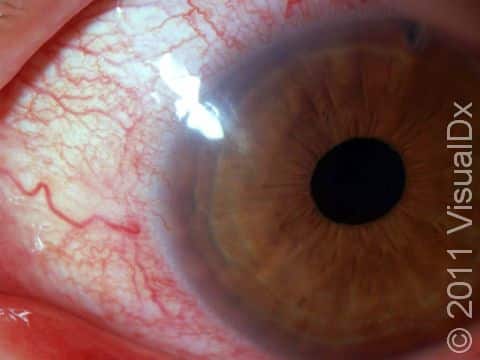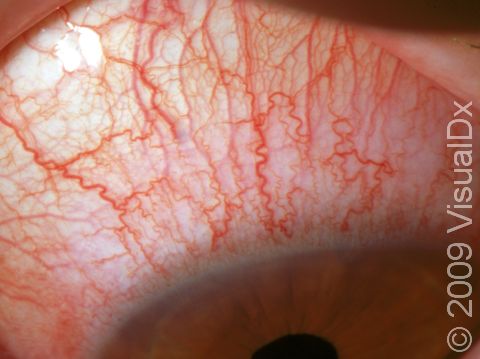Contact Lens Solution Toxicity
Contact lens solution toxicity refers to those conditions in the eye that are the result of an unwanted reaction to the use of such solutions. Not only might there be a reaction to the active ingredient in the solution but, many times, it is the vehicle (what the active ingredients are dissolved in) or the preservative in the solution that sets off the reaction. The reaction may be noninfectious (inflammatory), allergic, or both.
There are many different types of solutions used with contact lenses, and all can cause a toxic reaction. Such solutions include:
- Cleaning solutions
- Rinsing solutions
- Disinfecting solutions
- Multipurpose solutions
- Rewetting solutions
- Artificial tear products
Who's At Risk?
A large percentage of contact lens wearers experience reactions to contact lens solutions at some time. Most often, this occurs when there has been a switch to a new solution. But even after years of using the same product, the manufacturer may change the formula just enough to cause an issue. Contact lens wearers who are having problems with the fit and the comfort of their contact lenses are at greater risk of contact lens solution toxicity. Additionally, any other condition that might cause redness and irritation of the eyes will also make contact lens wearers more susceptible to contact lens solution toxicity.
Signs & Symptoms
Although you cannot see any distinct changes in the eye that would point only to a toxic reaction from a contact lens solution, there are good clues to suggest this type of reaction. One clue is that the trouble only seems to occur when you use a particular solution. Take note if the issue occurs following use of a previously used product, particularly if it has a label that says “new and improved.” Patients with contact lens solution toxicity can experience any or all of the following:
- Redness of the eye
- Pain
- Itching
- Tearing
- Decreased or blurred vision
- Discharge from the eyes
- Inability to wear the contact lenses
Self-Care Guidelines
Once you suspect that you might be having a reaction to a contact lens solution, stop using the product immediately and remove the contact lenses. Supportive measures include:
- Cold compresses for itching and swelling.
- Warm compresses for aching, pain, or discharge.
- Rinsing the eye(s) very gently with cool water.
- Never rubbing the eyes, as this will make the reaction worse.
Once the eye(s) are fully normal appearing and feeling, then you can try other brands or formulations of contact lens solutions.
Note:
Remember what product you used, when you used it, and how quickly you reacted. Toxic reactions can start out slow and mild the first time, but when you try the same product again, the toxic reaction will be worse, signaling that the solution is suspect. Always check expiration dates on your contact lens solutions, and never use expired products. Always handle your solutions carefully so as not to contaminate the tip of the bottle or can. If the tip gets contaminated with bacteria, it can lead to blinding complications. Finally, always make sure that the solutions you are using are compatible with your type of contact lenses.
Treatments
If the issue is ill-fitting contact lenses or you need to be tested with several types of contact lens solutions, the optometrist will do just that. The ophthalmologist may need to treat you with both eye drops and ointments depending on how severe the reaction is and what else might be associated with the problem.
Visit Urgency
If supportive measures and changing solutions once or twice don’t solve the problem, see an eye care professional. The optometrist can make sure the lenses fit correctly and guide you in lens solution choices. Additionally, the ophthalmologist is needed to make sure there is no underlying disease of the eye. The following situations require immediate medical attention:
- Progressive vision loss
- Progressive pain
- Thick or pus-like discharge
- No improvement or worsening of your eye condition after 24 hours without the use of contact lenses or exposure to contact lens solutions
Trusted Links
References
Yanoff M, Duker JS, eds. Ophthalmology. 2nd ed, pp. 82-83. St. Louis, MO: Mosby, 2004.
Last modified on October 10th, 2022 at 3:37 pm

Not sure what to look for?
Try our new Rash and Skin Condition Finder

